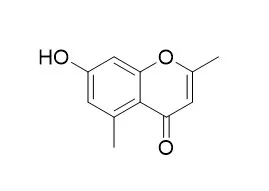| Description: |
Altechromone A has antimicrobial activity, it is active against Bacillus subtilis, Escherichia coli, Pseudomonas fluorescens and Candida albicans with the MICs of 3.9, 3.9, 1.8, and 3.9 ug/ml, respectively. |
| In vitro: |
| J Nat Prod. 2007 Jan;70(1):114-7. | | Cytotoxic benzo[j]fluoranthene metabolites from Hypoxylon truncatum IFB-18, an endophyte of Artemisia annua.[Pubmed: 17253861 ] |
METHODS AND RESULTS:
Two new benzo[j]fluoranthene-based secondary metabolites named daldinone C (1) and daldinone D (2), along with two known metabolites, Altechromone A and (4S)-5,8-dihydroxy-4-methoxy-alpha-tetralone, were isolated from the CHCl3/MeOH (1:1) extract of a solid culture of the endophyte Hypoxylon truncatum IFB-18 harbored inside the symptomless stem tissue of Artemisia annua. The structures of the new compounds were elucidated by MS and 1D and 2D NMR spectra and by X-ray diffraction analysis. Their absolute configurations were determined unambiguously by a combination of their CD data and the established exciton chirality rule.
CONCLUSIONS:
Compounds 1 and 2 were substantially cytotoxic against SW1116 cells, with IC50 values of 49.5 and 41.0 microM, respectively, comparable to that (37.0 microM) of 5-fluorouracil. The biosynthetic pathway for 1 and 2 was postulated with the natural occurrence of benzo[j]fluoranthene analogues discussed in brief. | | World Journal of Microbiology & Biotechnology, 2009, 25(9):1677-1683. | | Bioactive metabolites from Alternaria brassicicola ML-P08, an endophytic fungus residing in Malus halliana[Reference: WebLink] |
METHODS AND RESULTS:
A total of 48 strains were isolated from the normal tissues of Malus halliana and the EtOAc extracts of their cultures were subjected to primary antimicrobial screening against four test bacteria and three fungi. As a result, 22 strains exhibited antimicrobial activity against at least one test microbe. Among them, Alternaria brassicicola ML-P08 showing strong activity (MICs: 0.31–2.50 mg/ml) was selected for further investigation on its secondary metabolites. Bioassay-guided fractionation of the EtOAc extract of its liquid culture afforded seven compounds, which were identified as alternariol (1), alternariol 9-methyl ether (2), Altechromone A (3), herbarin A (4), cerevisterol (5), 3β,5α-dihydroxy-(22E,24R)-ergosta-7,22-dien-6-one (6) and 3β-hydroxy-(22E,24R)-ergosta-5,8,22-trien-7-one (7), respectively, by spectral means (MS, IR, 1H- and 13C-NMR).
CONCLUSIONS:
In vitro antimicrobial assay showed that compound 3 was substantially active against Bacillus subtilis, Escherichia coli, Pseudomonas fluorescens and Candida albicans with the MICs of 3.9, 3.9, 1.8, and 3.9 μg/ml, respectively. Compound 4 also showed pronounced antifungal activity against Trichophyton rubrum and C. albicans with MICs of both 15.6 μg/ml. In addition, compound 1 exhibited strong xanthine oxidase inhibitory activity with the IC50 of 15.5 μM, comparable to that of positive control, allopurinol (IC50: 10.7 μM). |
|






 Cell. 2018 Jan 11;172(1-2):249-261.e12. doi: 10.1016/j.cell.2017.12.019.IF=36.216(2019)
Cell. 2018 Jan 11;172(1-2):249-261.e12. doi: 10.1016/j.cell.2017.12.019.IF=36.216(2019) Cell Metab. 2020 Mar 3;31(3):534-548.e5. doi: 10.1016/j.cmet.2020.01.002.IF=22.415(2019)
Cell Metab. 2020 Mar 3;31(3):534-548.e5. doi: 10.1016/j.cmet.2020.01.002.IF=22.415(2019) Mol Cell. 2017 Nov 16;68(4):673-685.e6. doi: 10.1016/j.molcel.2017.10.022.IF=14.548(2019)
Mol Cell. 2017 Nov 16;68(4):673-685.e6. doi: 10.1016/j.molcel.2017.10.022.IF=14.548(2019)